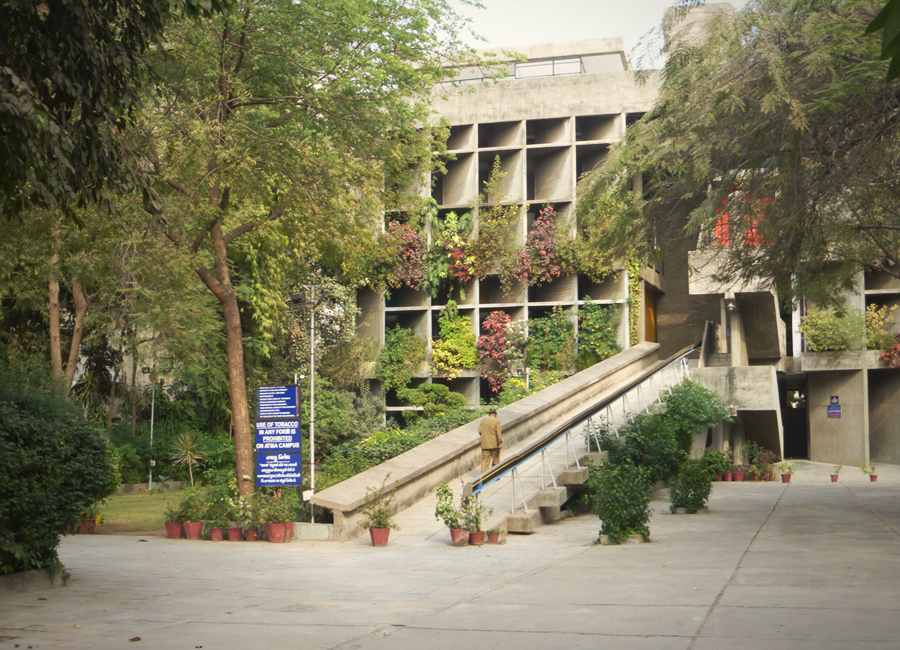|
Not having done much research prior to arriving in Ahmedabad I was pleasantly surprised to discover that the city had four Le Corbusier buildings. With a love of architecture and full of intrigue I had to find out more about why these buildings were here. In post-independent India of the early 1950’s Le Corbusier had been involved in planning the city of Chandigarh and designing several prominent government buildings. During his time in India he was commissioned by the president of the Mill Owners’ Association to design the organization’s headquarters in Ahmedabad along with 3 other domestic buildings. The secretary of the Millowners, Surottam Hutheesing also commissioned Le Corbusier to build him a house that showcased his social and economic position and reflected his modernist lifestyle and beliefs. The building symbolized Le Corbusier's domestic architecture whilst integrating the traditional features of Ahmedabad design. However, the plans were sold to fellow millowner, Shyamubhai Shodhan. Despite his different lifestyle and an entirely new site for the project, Shodhan elected to retain the original plans. Of the four buildings in Ahmedabad the Mill Owners’ Association Building and Villa Shodhan are accessible to the public. Despite Villa Shodhan still being a private residence we managed to sneak in and have a look around! Constructed in 1954, the Mill Owners’ Association Building is considered important as it clearly demonstrates a period of re-evaluation and reassessment for Le Corbusier. This is clearly evident through the drastic changes to his style from the previous decades and glaringly obvious in the Mill Owners’ Association Building and Villa Shodhan. During the period between 1945–1956, Le Corbusier started to incorporate and consider nature more frequently into his designs. The considerations of light, wind, rain and the addition of plants into the buildings in Ahmedabad are clear. Within the Mill Owners’ Association Building a rhombus of sunlight penetrates deep into the concrete structure whilst beautifully sculpted staircases seemingly float between floors. Working in predominately warmer environments Le Corbusier took his cues from traditional Indian architecture emulating large pillared halls and shady areas created by overhanging ledges. The Mill Owners’ Association Building sits between Ashram Road to the west and the Sabarmati River to the east. Openings on the west of the building are placed diagonally to obstruct views and noise from the street. The introduction of these angled thickened concrete facades and a brise-soleil, incorporated with the use of plants diffuse direct sunlight and prevent the inner areas from becoming too hot whilst still allowing a breeze to pass through. At the rear of the building a cool wind blows from the river through deep reveals and openings that also allow light to enter the lower spaces. Here the apertures frame views to the river below. Up on the parasol of Villa Shodhan there is a roof garden camouflaging the building with its environment. Le Corbusier’s work during this time took on many influences from the De Stijl movement. The parasol roof and the connectivity between the interior spaces in Villa Shodhan clearly reflect this. The window configurations and the asymmetry of the brise-soleil reflect the key symbols of the De Stijl movement that can be seen in the paintings of Mondrian. The Mondrian-esq rectilinear plan and grid of the Mill Owners’ Association Building’s exterior stand in stark contrast to the interior spaces. Inside large convex and concave volumes panelled in wood veneer act as lecture halls and meeting places whilst the interplay of harsh concrete shapes toy with ever-changing geometric sunlight that pierces the shade. Both the Mill Owners’ Association Building and Villa Shodhan are both fine examples of mid-century Le Corbusier modernism. These two fascinating and slightly unexpected buildings, in my opinion, are equally as historically important in the history of architecture in India as all the temples we visited!
0 Comments
Your comment will be posted after it is approved.
Leave a Reply. |
Archives
July 2020
Categories
All
|
Proudly powered by Weebly


 RSS Feed
RSS Feed